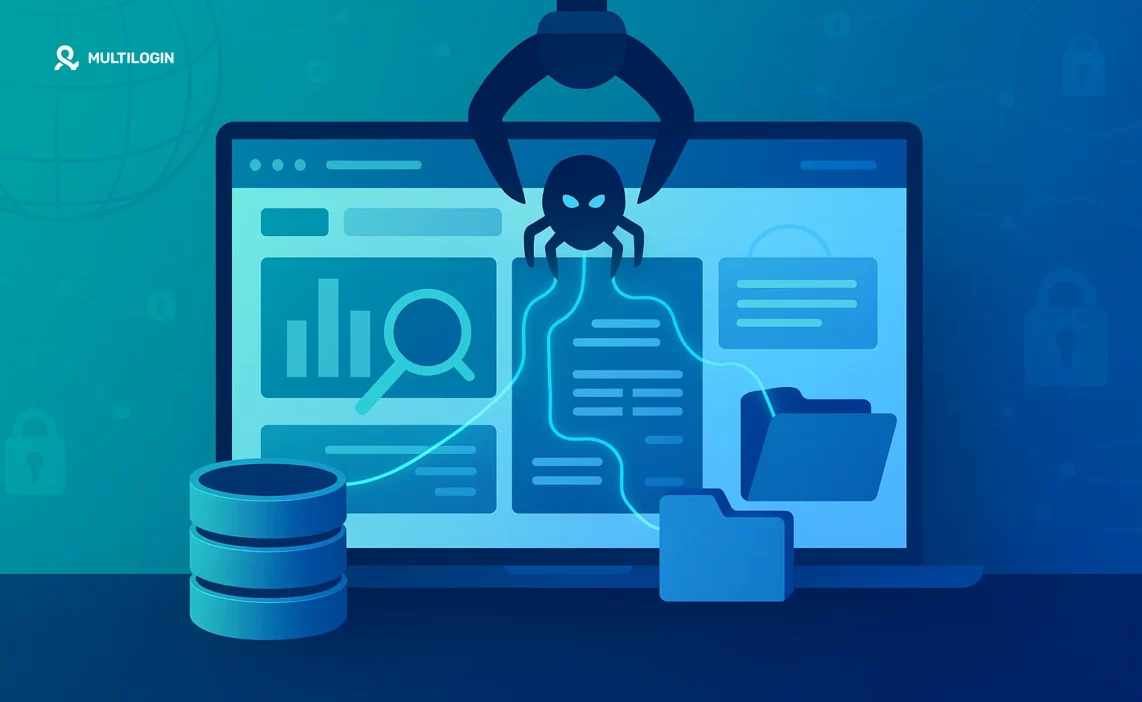Have you ever wondered how Amazon always knows the lowest prices, or how Expedia can show you hundreds of flight fares instantly? The answer lies in something called web scraping.
Web scraping is the process of extracting information from websites at scale. Instead of manually copying and pasting data, you use tools called web scrapers to collect prices, reviews, emails, or any online content automatically.
It’s everywhere—e-commerce giants, travel platforms, recruitment firms, financial analysts, and even researchers use it. But here’s the twist: while web scraping can be a business superpower, it’s also risky if you don’t know how to do it right.
Scrape without protection, and you’ll face:
- IP bans (blocked from sites you need)
- CAPTCHAs (constant interruptions)
- Legal or compliance issues (scraping data you shouldn’t)
So, what is web scraping exactly, how does it work, and how do you scrape without getting banned? Let’s break it all down in plain language—step by step.
What is Web Scraping?
At its simplest, web scraping is the process of automatically extracting data from websites using specialized software known as web scrapers.
Think of it as teaching a robot to “read” the internet. Instead of you copying prices from Nike.com or job ads from Indeed, a scraper can do it in minutes and save the results in a neat file.
Real-world example: Say you want to track the daily price of a sneaker across 10 websites. A scraper can check every page, pull the prices, and send you a CSV file every morning. That’s web scraping in action.
How Does Web Scraping Work?
The web scraping process usually follows these steps:
- Send an HTTP request – The scraper requests access to a webpage.
- Receive HTML – The site responds with its source code.
- Parse the HTML – The scraper analyzes tags, classes, and attributes.
- Extract specific data – It pulls only the data you want (prices, reviews, emails).
- Save results – Data is exported to CSV, JSON, Excel, or a database.
- Handle pagination – Scraper follows “next page” links for more results.
- Bypass anti-bot checks – Sites often deploy CAPTCHAs, IP bans, and browser fingerprinting.
- Automate updates – Advanced scrapers run daily, hourly, or even in real-time.
👉 Imagine it like a librarian. Instead of reading every book in the library, the scraper looks only for the exact info you want and records it neatly.
What is a Web Scraper?
A web scraper is the software (or script) that executes the scraping process. It’s the worker bee.
Key roles:
- Sends automated requests to websites
- Collects and structures data
- Saves it into readable formats
Types of web scrapers:
- HTML parsers – Extract data directly from raw code.
- DOM parsers – Target structured page elements.
- Browser extensions – Beginner-friendly scrapers inside Chrome/Firefox.
- Headless browsers – Full browsing simulation without visible interface.
So, when people ask “what is a web scraper used for?”—the answer is: everything from price tracking to lead generation.
Web Scraping Uses: Why It Matters
The real power of scraping comes from its applications.
What is web scraping used for? Here are the most common cases:
- Price Comparison – E-commerce stores scrape competitors to adjust prices.
- Lead Generation – Marketers scrape directories, LinkedIn, or forums for emails.
- Market Research – Companies scrape reviews for sentiment analysis.
- Content Aggregation – Media platforms scrape multiple news sources.
- Job Market Intelligence – Recruiters scrape job boards to track demand.
- Financial Forecasting – Analysts scrape stock and crypto data.
- AI Training Data – Datasets scraped for machine learning models.
In short: if data exists online, scraping makes it usable.
Types of Web Scraping
There are several methods, depending on your needs:
- Manual scraping – Copy-paste (inefficient, but still scraping).
- Automated scraping – Scripts/libraries (e.g., Python’s BeautifulSoup, Scrapy).
- API scraping – Extract via official APIs when available.
- Headless browser scraping – Simulates a real human user.
Headless browser scraping is the most powerful but also the riskiest. Without proper protection, websites will catch you via fingerprinting, CAPTCHAs, and IP blocks.
That’s why professionals use antidetect browsers like Multilogin.
Web Scraping vs. Web Crawling
A common question: “what is website scraping vs. crawling?”
- Web crawling – Bots scan websites, follow links, and index content (Google does this).
- Web scraping – Extracts specific structured data (prices, emails, product details).
Think of crawling as exploring a city, and scraping as collecting souvenirs from it.
👉 More here: Web Crawling vs Web Scraping.
Is Web Scraping Legal?
The most debated question: “is scraping a website legal?”
Answer: It depends.
- Allowed: Public data (like government databases, stock prices).
- Grey area: Data on sites that forbid scraping in their Terms of Service.
- Not allowed: Scraping personal info (emails, phone numbers) without consent (GDPR, CCPA).
👉 Learn more: Is Web Scraping Legal?
So, scraping itself isn’t illegal—but how and what you scrape can be.
Multilogin for Large-Scale Web Scraping
This is where Multilogin comes in.
Unlike VPNs or proxies alone, Multilogin creates unique browser identities that look like real humans, not bots.
Why Multilogin is perfect for scraping:
- Antidetect Technology – Generates undetectable browser fingerprints.
- Built-in Residential Proxies – Included in every plan, no extra cost.
- Automation-Ready – Works with Puppeteer, Selenium, Playwright.
- Profile Isolation – Each project/account runs in its own safe container.
- Cookie Management – Pre-farmed cookies to warm up accounts before scraping.
- Mobile Device Simulation – Run Android profiles for mobile-first sites.
👉 Bonus: Multilogin is an all-in-one proxy browser, not just a scraper helper. No need for multiple tools—everything is built in.
VPN vs Proxy vs Multilogin for Scraping
Feature | VPN | Proxy | Multilogin |
Changes IP Address | ✅ | ✅ | ✅ |
Unique Browser Fingerprint | ❌ | ❌ | ✅ |
Avoids Fingerprinting | ❌ | ❌ | ✅ |
Built-in Proxies | ❌ | ❌ | ✅ |
Multi-Account Management | ❌ | ❌ | ✅ |
Automation Integration | ❌ | ❌ | ✅ |
Verdict: VPNs and proxies help, but Multilogin is the only solution that keeps scrapers undetectable long-term.
Frequently Asked Questions About Web Scraping
It’s automated data extraction. It works by requesting web pages, parsing HTML, and pulling structured info.
Both mean the same—web scrapping is just a common misspelling.
It automates website data collection—prices, reviews, contact info, product details.
Small projects can use Python libraries or Chrome extensions. For large-scale scraping, pair your scraper with Multilogin to prevent bans.
Yes. Even withå
Tools like Octoparse, ParseHub, or Apify. But they still need stealth tech to avoid bans.
browser fingerprint protection, your IP address matters. Pairing an antidetect browser with high-quality residential proxies ensures both identity and location spoofing for better Facebook compliance.
Web scraping collects raw data. Data mining analyzes patterns and insights from that data.
Scale Data Collection Without Risks
We’ve covered it all:
- The web scraping meaning
- How scrapers work
- The uses of web scraping in real industries
- Why Multilogin is the safest way to scrape at scale
Here’s the reality: web scraping is a business superpower. But only if you do it smart. Without stealth, you’ll face bans, CAPTCHAs, and wasted effort. With Multilogin, you can:
- Scrape safely with undetectable fingerprints
- Use built-in residential proxies without setup
- Automate scraping across 100s of sessions
- Manage multiple scraping projects without bans
Your competitors are already scraping. The question is: will you do it smarter, safer, and at scale—or get left behind?


